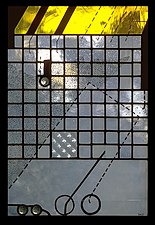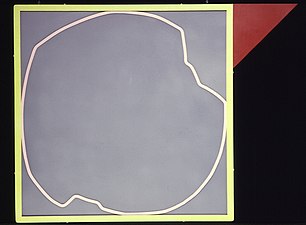Autonomous stained glass

The term "autonomous" as applied to stained glass refers to works which are designed independent of architecture. Autonomous works are not designed to glaze windows. The term "stained glass" commonly precedes "window" and is thus linked to architecture both linguistically and conceptually. The autonomous work is more like a painting than a stained glass window, and is a non-traditional use of the medium.[1] One critic somewhat pejoratively calls non-architectural stained glass "uncommissioned panels."[2] Another traditionalist claims: "Stained glass can never be really satisfactory when considered as a bibelot to be hung up in the window or when sold in galleries like paintings for room decoration."[3]
From the Renaissance (
In the book Twentieth Century Stained Glass: A New Definition, art critic Robert Kehlmann points out that making a stained glass panel and designing a window are two different disciplines. Autonomous glass artists generally fabricate their own work, very often experimenting with materials, technique, and the uses of light. They freely "address a wide range of ideas and feelings without concern for the form and mood of a building." The size, shape and imagery of an autonomous stained glass work is "dictated solely by the nature of materials and personal aesthetics."[8]
- Autonomous Stained Glass Works
-
Robert Kehlmann, Composition XXXIX (1977), 33 X 38, Leigh Yawkey Woodson Art Museum, Wausau, WI
-
Peter Mollica, Glass Drawing 1a, (1977), destroyed
-
The Wilhelmy American Flag Glass Pipe Organ
-
Casey Lewis, Harpo Marx (1976) 26 X 26, Corning Museum of Glass
-
Richard Posner, Persistence of Vision (1975), Metropolitan Museum of Art
References
- ^ Sowers, Robert (1965). Stained Glass: An Architectural Art. New York: Universe Books, Inc. p. 166.
- ^ a b c Sowers, Robert (1981). The Language of Stained Glass. Forest Grove, Oregon: Timber Press.
- ^ John Baker in Trevor Dannatt, ed., Architects’ Yearbook 6, Elek Books, Ltd., London, 1955
- ^ Robert Kehlmann, "Glass as a Free Art Form," Neues Glas, January, 1983
- ^ 6. Casey Lewis, "Robert Kehlmann: Richmond Art Center, Richmond California," Glass Art, Vol.4, No. 1976
- ^ "New Stained Glass," Museum of Contemporary Crafts, New York, 1978 (catalog)
- ^ Robert Kehlmann, "Stained Glass as a Non-Architectural Art," Glass Art Magazine, December, 1975
- ^ Kehlmann, Robert (1992). Twentieth Century Stained Glass: A New Definition. Japan: Kyoto Shoin Ltd. p. 242.





